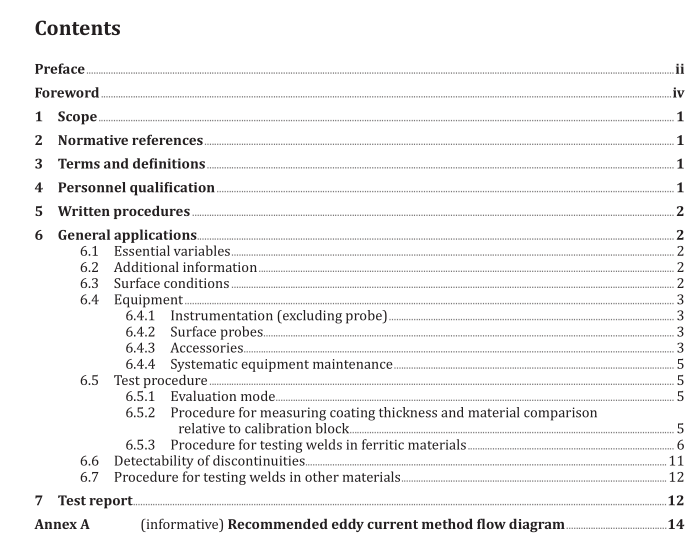AS ISO 17643 pdf download – Non-destructive testing of welds — Eddy current testing of welds by complex- plane analysis

AS ISO 17643 pdf download – Non-destructive testing of welds — Eddy current testing of welds by complex- plane analysis
The instrument used for eddy current testing in accordance with this International Standard shall becapable of analysis and display in the complex plane.The amplitude and phase of eddy current signalsshall be measurable.
6.4.1.2Frequency
The eddy current instrumentation shall be able to operate at a selected frequency within the range1 kHz to 1 MHz.
6.4.1.3Signal display
The display shall include the facility to freeze eddy current signals on screen until reset by the operator.The trace shall be clearly visible under all lighting conditions expected during testing.
6.4.1.4 Phase control
The phase control shall be able to give complete rotation of displayed signals (360 ) in steps of no morethan 10 each.
6.4.2Surface probes
6.4.2.1 Probes for measuring coating thickness and material evaluation relative tocalibration block
The probe shall operate in the absolute mode at a selected frequency in the range from 1 kHzto 1MHz.All the probes shall be clearly marked with their operating frequency range.
6.4.2.2 Probes for testing of welds
For testing of ferritic welds, probes specially designed for this purpose shall be used.The coils assembly shall be orthogonal, tangential or equivalent.
The electrical connection shall enable differential measurements which are characterized by having aminimal dependency on continuous or small variations in conductivity, permeability and lift-off in thewelded and heat-affected zones.
The diameter of the probe shall be selected relative to the geometry of the component under test. Suchprobes shall be able to operate when covered by a thin layer of non-metallic wear-resistant materialover the active face. If the probe is used with a cover, then the cover shall always be in place duringcalibration.The probe shall operate at a selected frequency in the range from 100 kHz to 1MHz
6.4.3Accessories
6.4.3.1Calibration block
A calibration block, of the same type of material as the component to be examined, shall be used. Itshall have EDM (electric discharge machined)notches of 0,5 mm, 1,0 mm, and 2,0 mm depth, unlessotherwise specified, for example in an application standard. The tolerance on the notch depth shallbe ±0,1 mm.T’he recommended width of the notches is ≤ 0,2 mm.An example of a calibration block isshown in Figure 1.
6.4.3.2 Non-conductive flexible strips
Non-conductive flexible strips of a known thickness to simulate the coating or actual coatings on thecalibration block shall be used.
The thickness of the non-conductive flexible strips should be multiple of 0,5 mm.6.4.3.3 Probe extension cables
Extension cables may only be used between the probe and the instrumentation if the function,sensitivity and the resolution of the whole system can be preserved.
6.4.3.4 Remote display and control
For operation with long extension cables, the equipment shall include a device for remote signal displayat the operator’s location.
6.4.4Systematic equipment maintenance
6.4.4.1Calibration certificate
The equipment(instrument and probes) shall have a currently valid calibration certificate.This may beissued by the manufacturer, (in accordance with IS0 15548-1 and IS0 15548-2) a recognized calibrationlaboratory or an authorized agency.
6.4.4.2 Functional check
Maintenance shall follow IS0 15548-3 or a written procedure.The results of maintenance checks shallbe recorded.
6.5Test procedure
6.5.1 Evaluation mode
The evaluation mode shall use both phase analysis and amplitude analysis of a vector traced to thecomplex plane display.Evaluation may be by comparison of this display with the reference datapreviously stored.
6.5.2 Procedure for measuring coating thickness and material comparison relative tocalibration block
Connect the probe for absolute measurements to the instrument. Select the appropriate frequencySet the gain of the instrument in order to obtain a full screen deflection lift-off signal when the probeis moved from an uncoated spot on the calibration block to a spot covered with the maximum coatingthickness expected on the structure to be tested.
Set the phase of the lift-off signals to display them as shown on Figure 2.
The coating thickness on the raw surface of a weld is never constant.As it will influence the sensitivityof crack detection, it is necessary to get an estimate of the maximum coating thickness in the heat-affected zone prior to the eddy current testing of the weld.
The lift-off signal obtained from the component to be tested shall be similar to the signal obtained fromthe calibration block, i.e. it shall be within 5 ° either side of the reference signal (see Figure 2). In theevent that the signal is out of this range, a calibration block more representative of the material to beexamined shall be produced/manufactured.









